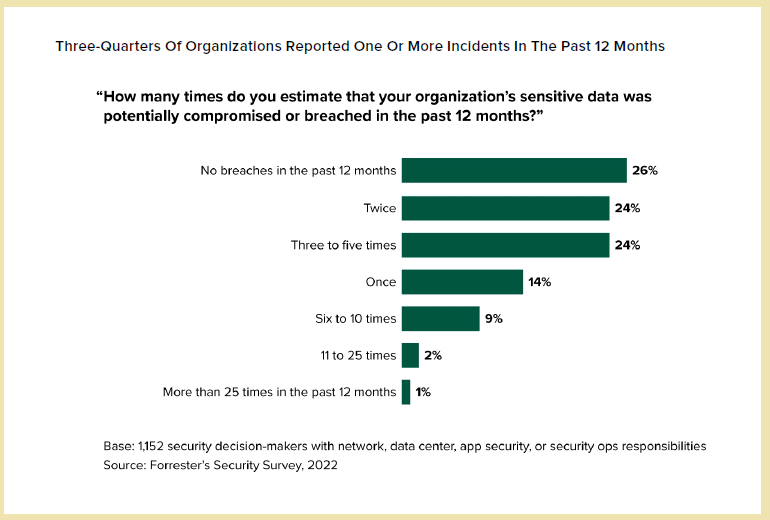Cyberattacks have been a pain for regular internet users since the inception of the world wide web, but in spite of the fact that this is the case, not all that much headway has been made in terms of mitigating them. Whenever an advancement makes cyber threats less of an issue, malicious actors are able to take things up a notch to circumvent the new security protocols and make their own attacks more dangerous than might have been the case otherwise.
With all of that having been said and now out of the way, it is important to note that 74% of cybersecurity experts admitted that their organizations had been breached in the past year. A report released by Forrester dives a bit deeper into this trend, and its findings are concerning to say the least.
Out of the security experts whose organizations were compromised, 24% said that their security protocols had been breached twice, and a further 24% stated that this had happened between 3-5 times. Only 14% said that just a single attack occurred, with 9% mentioning six to ten breaches, 2% citing 11-25 cyberattacks and 1% having faced more than two breaches a month or twenty five in total to be precise.
A major hurdle for cybersecurity experts is the growing complexity of cloud computing. 75% of organizations are worried about the security of their cloud stored data, and it is estimated that around 66% of application software spending will go towards cloud storage by 2025.
This is up from the 58% that can be seen in 2023, and it suggests that cloud security will become far more essential over the next few years. In light of these threats, 83% of organizations are adopting private cloud hosting. 83% are also using internal private clouds, with 84% using public cloud access.
A major consideration for cybersecurity experts this year will be rising geopolitical tensions around the world. Russia’s invasion of Ukraine involved an endless series of cyberattacks because of the fact that this is the sort of thing that could potentially end up destabilizing the nation while it was being invaded.
Ransomware is a popular choice for these international bad actors. Between 2016 and 2021, the number of ransomware attacks doubled with all things having been considered and taken into account. This tactic also gets used to disrupt supply chains since the high stakes can allow malicious actors to extract sizable ransoms.
Out of all the insurance claims that were noted, BEC social engineering tended to incur the most losses for businesses. Around $2.4 billion was lost to these attacks in 2021, and in 2022, these attacks surpassed even ransomware in terms of the losses that they could force businesses to endure. The threat landscape is ever changing, and businesses need to stay on their toes to keep up with them and keep them at bay.
Read next: New Anti-Malware Testing Report Names Microsoft’s Defender, Kaspersky, Bitdefender, And Total Defense As The Best Against Web Threats
With all of that having been said and now out of the way, it is important to note that 74% of cybersecurity experts admitted that their organizations had been breached in the past year. A report released by Forrester dives a bit deeper into this trend, and its findings are concerning to say the least.
Out of the security experts whose organizations were compromised, 24% said that their security protocols had been breached twice, and a further 24% stated that this had happened between 3-5 times. Only 14% said that just a single attack occurred, with 9% mentioning six to ten breaches, 2% citing 11-25 cyberattacks and 1% having faced more than two breaches a month or twenty five in total to be precise.
A major hurdle for cybersecurity experts is the growing complexity of cloud computing. 75% of organizations are worried about the security of their cloud stored data, and it is estimated that around 66% of application software spending will go towards cloud storage by 2025.
This is up from the 58% that can be seen in 2023, and it suggests that cloud security will become far more essential over the next few years. In light of these threats, 83% of organizations are adopting private cloud hosting. 83% are also using internal private clouds, with 84% using public cloud access.
A major consideration for cybersecurity experts this year will be rising geopolitical tensions around the world. Russia’s invasion of Ukraine involved an endless series of cyberattacks because of the fact that this is the sort of thing that could potentially end up destabilizing the nation while it was being invaded.
- Note: Avoid using same passwords everywhere. Try our strong Password Generator.
Ransomware is a popular choice for these international bad actors. Between 2016 and 2021, the number of ransomware attacks doubled with all things having been considered and taken into account. This tactic also gets used to disrupt supply chains since the high stakes can allow malicious actors to extract sizable ransoms.
Out of all the insurance claims that were noted, BEC social engineering tended to incur the most losses for businesses. Around $2.4 billion was lost to these attacks in 2021, and in 2022, these attacks surpassed even ransomware in terms of the losses that they could force businesses to endure. The threat landscape is ever changing, and businesses need to stay on their toes to keep up with them and keep them at bay.
Read next: New Anti-Malware Testing Report Names Microsoft’s Defender, Kaspersky, Bitdefender, And Total Defense As The Best Against Web Threats

